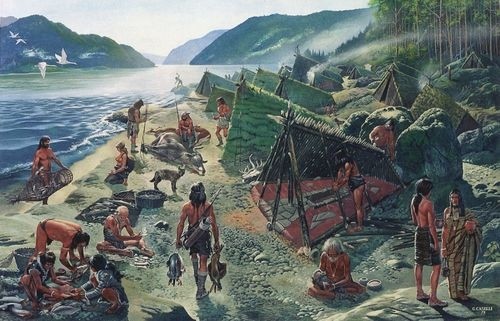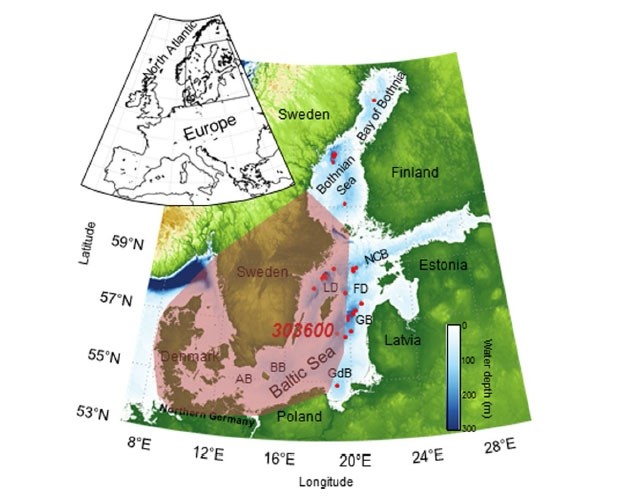Snelle opwarming zorgde voor opkomst landbouwmaatschappij in Noord-Europa
Waardoor kwam de transformatie van de jager- en verzamelaarsamenleving naar een landbouwmaatschappij zo laat op gang in Noord-Europa vergeleken met de rest van Europa? Klimaatverandering in het mid-Holoceen lijkt de meest logische oorzaak voor deze late neolithische revolutie, maar wanneer die omschakeling precies plaatsvond bleef lang onduidelijk. Multidisciplinair onderzoek van een internationaal team van geologen, geochemici, archeologen, visbiologen en ecosysteem modelleurs naar temperatuurontwikkelingen gedurende het mid-Holoceen in de Baltische regio biedt een nieuwe kijk op de omwenteling. Geochemisch onderzoek van het NIOZ, Koninklijk Nederlands Instituut voor Onderzoek der Zee leverde een nieuwe zeewatertemperatuur curve op van dit geologische tijdvak en helpt daarmee verklaren wanneer klimaatverandering tot demografische en culturele veranderingen moet hebben geleid, aldus wetenschappelijk tijdschrift Scientific Reports.

Het is voor het eerst dat de Nederlandse TEX86-methode, waarmee indirect de temperatuur van het oppervlaktewater wordt gemeten, is toegepast op het uitlezen van sedimentkernen afkomstig uit de bodem van de Baltische Zee. Deze kernen bevatten informatie in hoge resolutie over een tijdperk zo'n 7.100 – 3.000 duizend jaar geleden. Ze onthullen een fascinerende temperatuurgeschiedenis die verklaart waarom de samenleving in de Baltische regio pas 1500 jaar later dan het Europese continent transformeerde van een jager- en verzamelaarsamenleving naar een landbouwmaatschappij.
De zoektocht naar watertemperaturen uit het verleden
"TEX86 functioneert als de paleothermometer in ons onderzoek", vertelt Jaap Sinninghe Damsté, biogeochemicus bij het NIOZ en hoogleraar aan de Universiteit van Utrecht. "Deze thermometer is gebaseerd op overblijfselen van de zogenoemde Thaumarchaeota micro-organismen. Deze microben stemmen de samenstelling van hun membraanlipiden af op de watertemperatuur." Wanneer Thaumarchaeota sterven en naar de bodem zinken, wordt deze 'membraan-informatie' in het sediment opgeslagen, en via een chemische analyse kan zij worden 'terug gelezen'. "Uit onze analyse blijkt dat de zomertemperatuur van het oppervlaktewater varieerde van 14,5 tot 17,5 graden Celsius. De TEX86 curve laat een langdurige onstabiele, maar over het algemeen koudere fase zien tussen 7 en 6 duizend jaar geleden, gevolgd door een snelle opwarming met als hoogtepunt de tijdsperiode tussen 5.600 en 4.500 jaar geleden."

Snelle demografische reactie op klimaatverandering
"Als we deze resultaten vergelijken met onze archeologische bevindingen, zien we een duidelijke overeenkomst." Stephan Shennan, archeoloog van het University College London analyseerde de demografische ontwikkeling van de Baltische regio in het mid-Holoceen. "Kort na zes duizend jaar geleden zien we een snelle stijging van de bevolkingsdichtheid die gelijk loopt met de fase waarin het warmer werd. Ook kunnen we aan de hand van culturele overblijfselen concluderen dat deze ontwikkelingen parallel lopen met de ontstaansgeschiedenis van de landbouwsamenleving in de Baltische regio." De aanzienlijke temperatuurstijging bood ideale omstandigheden voor succesvolle landbouwactiviteiten en mogelijkheden voor Europese agrariërs om uit te breiden naar het noorden. "Onze studie laat zien dat de bevolking slechts twee tot drie generaties nodig heeft gehad voor deze omschakeling. Dat benadrukt dat mensen zeer flexibel en snel kunnen reageren op klimaatverandering", vervolgt Shennan.
Om zijn theorie te bevestigen had Shennan echter gegevens nodig van de temperatuur in de Baltische regio uit het mid-Holoceen. Het onderzoek van de sedimentkernen in hoge resolutie was daarom een essentieel onderdeel van deze studie. "We hebben een multi-proxy-benadering ontwikkeld om zoveel mogelijk informatie uit de zeebodemkernen te halen." Matthias Moros, geoloog aan het Leibnitz-instituut voor onderzoek aan de Oostzee (IOW) coördineerde het project samen met Sinninghe Damsté. "De kernen wezen ons al op een duidelijke verschuiving rond 6 duizend jaar geleden. We zagen dat de structuur van de sedimentlagen volledig veranderen van homogeen naar gelaagd, hetgeen duidt op de afwezigheid van zuurstof in het bodemwater. We weten nu dat dit werd veroorzaakt door temperatuurstijging."
Effect op visbestanden
Tenslotte toonde zijn collega, IOW ecosysteem modelleur Thomas Neumann aan dat het niet een lokaal, maar regionaal fenomeen in de Baltische regio betrof. Hij concludeert: "Ons model biedt een causaal verband tussen temperatuursveranderingen en milieuomstandigheden en zijn terug te zien in gegevens die uit de analyses van de sedimentkernen komen. We menen ook dat de zuurstofloosheid de visbestanden in de Baltische Zee negatief moet hebben beïnvloedt en dat dit gevolgen moet hebben gehad voor de waargenomen culturele veranderingen." Jaap Damsté voegt toe: "Helaas waren de archeologische gegevens waren niet sterk genoeg om dit te bevestigen." Toch vindt hij dat deze studie de kracht van multidisciplinair onderzoek laat zien. "Uiteindelijk heb je al deze wetenschappelijke disciplines nodig om de geschiedenis van de mens beter te begrijpen."
Artikel:
Warden, L., Moros, M., Neumann, T., Shennan, S., Timpson, A., Manning, K., Sollai, M., Wacker, L., Perner, K., Häusler, K., Leipe, T., Zillén, L., Kotilainen, H., Jansen, E., Schneider, R.R., Oeberst, R., Arz, H. & Sinninghe Damsté, J.S., Climate induced human demographic and cultural change in northern Europe during the mid-Holocene. https://doi.org/10.1038/s41598-017-14353-5
Rapid mid-Holocene warming triggered the onset of a farming society in Northern Europe
It is for the first time that the so called biomarker TEX86, acting as a proxy for sea surface temperature, was applied on a sediment core from the central Baltic Sea covering the time span from 7.100 – 3.000 years before present (BP) in high resolution. It reveals a fascinating temperature history, which provides an explanation why the transition from hunter-gatherer-fishing-groups to farming society (the Neolithic revolution) reached the Baltic area as late as 1.500 years after it appeared in the neighbouring areas in the South.
Paleothermometer
“The TEX86 biomarker serves as a kind of paleothermometer”, explains Lisa Warden, a former PhD student at the NIOZ Royal Netherlands Institute for Sea. “It is based on the remains of certain microorganisms, so-called Thaumarchaeota. The composition of their membrane lipids change according to sea temperature. When the Thaumarchaeota die and sink to the seafloor, this information gets archived and can be retrieved by chemical analysis of these fossils.” During the investigated time span, these analyses showed a temperature range from 14.5 to 17.5 °C in the sea surface in summer. The TEX86 record detects a prolonged unstable but generally colder phase from 7.000 to 6.000 BP, followed by a distinct and rapid warming, which culminates in two temperature maxima at 5.600 and 4.500 years BP. Thus, in the Baltic Sea region the “Holocene Thermal Optimum” lasted only from 5.900 to 4.400 years BP.
Striking parallel development
“Comparing these results with archaeological findings shows a striking parallel development.” Stephen Shennan, archaeologist at the University College London, has analysed the population development during the respective period. “From shortly after 6.000 years BP on we recognize a sharp increase in the population density parallel to the warming phase. We also see by the archaeological evidence that this goes with the onset of farming in the western Baltic Sea region. „With the significant increase in temperature, the scene was set for successful farming and an expansion of agrarian groups from the South. “Our study suggests a rapid human reaction within only two to three generations to these new opportunities emphasizing the remarkable plasticity humans can demonstrate in response to climate change,” resumes Shennan.
The strength of multidiciplinary studies to understand human history
The backbone of the analyses was the recovery and dating of high resolution sediment cores. “We have developed a multi-proxy approach in order to drag as much information from the sediment cores as possible.” Matthias Moros, geologist at the Leibniz-Institute for Baltic Sea Research (IOW) coordinated all analyses related to the sediment archives. Together with his colleague Jaap Sinninghe Damsté, a biogeochemist at NIOZ and professor at Utrecht University, he designed the scientific approach of this study. “We knew already from the sediments that there was a distinct shift around 6.000 years BP: the sediment structure changed completely from homogenous to laminated. This is clear evidence for a change in the oxygen conditions at the sea floor. We know now, that this was triggered by the temperature rise.” His colleague, IOW ecosystem modeller Thomas Neumann, showed that this was not a local but a regional phenomenon influencing the Baltic as a whole. He concludes: "Our model provides a causal mechanism between temperature change and environmental conditions as reflected in the sedimentary record.”
“We also speculated that the spread of anoxia must have affected the fish stocks in the Baltic at that time and that this must have been a trigger for the observed cultural changes” Jaap Damsté adds “but the archaeological data were not strong enough to claim this.” He concludes: “This study clearly reveals the strength of multidisciplinary studies to understand human history”.
Warden, L., Moros, M., Neumann, T., Shennan, S., Timpson, A., Manning, K., Sollai, M., Wacker, L., Perner, K., Häusler, K., Leipe, T., Zillén, L., Kotilainen, H., Jansen, E., Schneider, R.R., Oeberst, R., Arz, H. & Sinninghe Damsté, J.S., Climate induced human demographic and cultural change in northern Europe during the mid-Holocene. https://doi.org/10.1038/s41598-017-14353-5